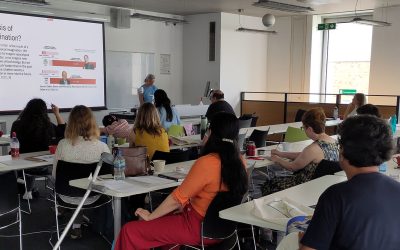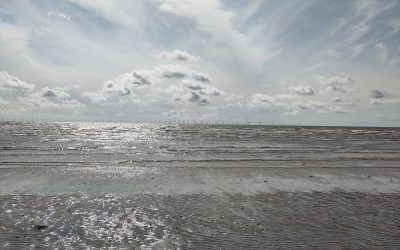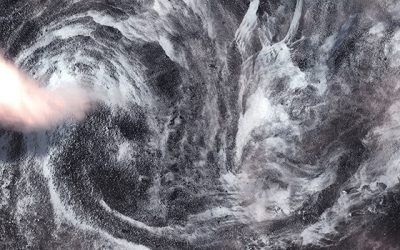By Dr. Sharon Wilson, Newcastle Business School, Northumbria University
This is the second part of a 2-part series Dr. Wilson is writing on tourism and activism related to nuclear sites. For more about Dr. Wilson and her work, visit her faculty page. To read the first entry in this essay, click this link.
Art and Tourism
By engaging with contested sites of leisure and capturing these travel experiences through photography, drawing and community participation, it is suggested that the art of touring politely disrupts the status quo of places visited because it can critically engage with the issues of atomic power through the gentle lens of art. Whilst other artists have looked at the nature of art and tourism and art and the toxic, (Martin Parr, Cornelia Hesse-Honegger, and Isabella Mongelli for example) what is subtle and effective about this project is the process by which it uses an established form, a family vacation, to critically engage with toxic smells, sounds, contagions, stories and imaginaries as a form of cultural production and political debate. The 30-day tour culminated in a body of work which includes a range of creative musings from pastiches of family portraits to self-styled souvenir drawings of the nuclear power stations, oral histories of residents, security guards, police and employees who live and work in intimate proximity to the nuclear ‘factories’.
The almost ubiquitous nature walks (which formed part of the artistic ‘family activities’) were often remote and yet industrial. Their setting against the ‘romantic idealism’ in the highly managed safe zones of public nature reserves revealed a paradoxical symbiosis between the banal landscapes of industrialisation, environmental toxicity and the itineraries of conservation which seek to preserve and maintain nature. Interestingly, anecdotal evidence from visitors to these places which tried to mix local tourism with the nuclear said that they didn’t feel comfortable photographing a nuclear site in spite of nature paths passing through or adjacent to the stations. By investing in conservation and promotion of local tourism, another juxtaposition between the mundane architecture of the functional factory is set against the equally manufactured, ecologically ‘sustained’ environment with conservation of the nature that surrounds the factories tempering the perceived threat to public health. Whilst conventional leisure seekers travel to contemplate picturesque landscapes through a romantic gaze, travel to these sites is foreshadowed by the perceived dangers associated with nuclear facilities.
Many of the planned artistic interventions occurred in residential areas associated with the nuclear sites and travel in this sense allowed hosts and guests to meet in fleeting encounters; the format of a family on holiday in a caravan had an innocence and novelty about it which allowed the artists to explore environmentalist issues without themselves being ostracised. As Lindsay pointed out:
We were playing out being tourists, being slightly disruptive and inquisitive even ignorant, sort of ‘oh what’s going on here’ type thing. It allows you to take any role that you want. You can talk to the train spotters or the ex-worker from the nuclear industry. I don’t think many people actually thought we were tourists but I think they quite liked the fact we opened up the possibility that you could tour nuclear power stations. The idea of setting up a new paradigm of how and why you might want to travel, a kind of informal activism and leaving perhaps a legacy for a kind of new form of tourism seemed like a plan. Because of the art side of it, you are acting as a tourist, so it is tourism development in a strange way. As a family we made a tourist itinerary of motor boating, kite flying or swimming in the sea. But they were all set within a nuclear framework; doing them next to a power station added a weird element of risk.
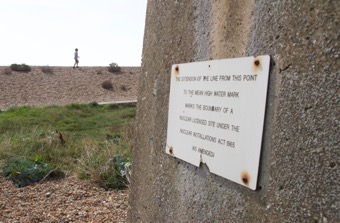
The ‘nuclear family’ moniker (in this case, the idealised white Anglo-Saxon version of the nuclear family23 ) is the post-war idea of the family which itself alludes to the security in conformity. It is this conformity set against the backdrop of a somewhat ambivalent relationship with nuclear energy that underpins the family photographs. Taken at each destination, they represent an attempt to begin a dialogue which locates threat. Here, the traditional poses both allude to the conventions of expressing togetherness in a happy family holiday, whilst also being a reminder of the toxic landscapes which contextualise these portraits. By engaging in family activities at each of the destinations, the aim was also to engage a wider audience through the cultural media genres of literature, film and art, adding narratives to public debates on the environment, on beauty and toxicity. Through the genteelism of art production, this narrative can be a ‘quiet riot’ in the otherwise undisturbed experience of the everyday. So, from the realm of artistic appreciation in a banal landscape, the radioactive ‘elephant in the room’ is temporarily made visible by a family on holiday. They are not, of course, an entirely conventional family, but rather a publicly funded one which travels to make art: the Nuclear Family Project is in this sense a form of alternative ‘niche’ tourism but hosted under the rubric of ‘environmental tourism’ and mediated through an artistic practice. By their own admission, The Nuclear Family Project are artists and not activists. Because of the form of their project, they are also ‘holiday makers’. In contrast to the idealised notions of a white, happy family on a beach (Obrador-Pons)24 this is juxtaposed with the arguably darker aura of the toxic landscape; spaces of leisure and family activities as played out in the contested spaces of the nuclear industry. The artists, in holidaying in these places, wished not only to use tourism for contemplating the strangeness of industrial landscapes but also as antithesis to the more traditional forms of tourism such as the beach holiday:
I had no idea what it would be like to tour nuclear sites. I didn’t even know if you could get close to them. They are fenced off, but fenced off right next to the building and were surprisingly accessible – that really surprised me. I mean, even Dounreay, an ex-military site had a nice viewing area that was made for tourists. It has informative panels and yet was one of the nuclear research places during the Cold War, I believe it would have been top secret. They are now promoting tourism and have even built a massive car park to encourage people to hang around. Wylfa has a visitor centre, and Trawsfynydd is a tourist spot again – now that the reactors don’t heat up the lake water. In fact, it’s now a leisure lake with watersports, fishing and Ospreys.
By touring nuclear sites, The Nuclear Family are able to re-engage both hosts and guests (and most importantly audience) in a debate about the social reality of nuclear threat. As Pezzulo25 points out, tourism is romanticised for its promise of pleasure, and yet tourism may also enable exploitation of other cultures. In the case of the environmental justice movement, raising awareness about polluted communities and reducing the physical distance between hosts and guests serves to redress this. Being a creative family on holiday, the danger of ‘othering’ its host is reconciled by the artists’ reciprocal engagement with, for example, place. Making work that does not preach about the nuclearity of the destination, and has an appreciation for aesthetics with a genuine concern and sympathy for local issues, is arguably a more ethical encounter with its host.
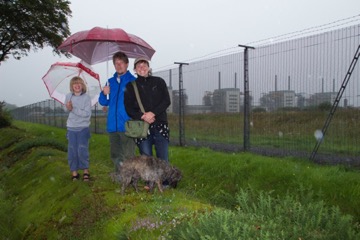
When visiting these industrial towns, the artists used a variety of tactics to engage with both the public and the surrounding areas which they wished to explore. As participants in this somewhat unlikely holiday, the artists, as suspect holidaymakers, mimicked the performances of conventional leisure tourism by engaging in activities such as beach walking, fishing, sightseeing, apparently behaving like any other visitor. Another approach was to park their caravan in public areas such as car parks and roadsides near the nuclear facilities, intending to prompt reactions to their unusual presence. Using such leisure spaces for family activities naturally led to tourist encounters with residents who lived and worked with nuclear reactors on their doorstep. Interactions included conversations with the communities about the positive and negative impacts of nuclear factories in their neighbourhoods. So, instead of exploiting the destinations encountered, Marek and Lindsay made art which, while addressing an environmentalist agenda, also involved the local community as a way of giving something back. The artists as tourists were as curious about where to find the souvenir shop as they were at disclosing uncomfortable truths, striking up conversations on difficult topics with non-threatening naivety. By performing family holiday activities close to a nuclear facilities, rhetorical questions are raised around safety, security and what can be construed as acceptable leisure pursuits in toxic zones.
As Marek observed:
In Sizewell there is a managed walk that highlights butterfly spotting and right next to it is a sign about what to do if there’s a disaster, you know, go home close your windows etc. Weirdly the campsites right next to some of them are really beautiful. Sandy Bay camp site’s promotional material talks about wildlife and proximity to the Sizewell sands beach, and stunning Suffolk coastal walks yet completely fails to mention that it’s directly next to two enormous nuclear power stations. When we arrived and talked to the woman at reception, I said we had come to see the nuclear power station and she stopped and gave me an uncomfortable look then regained her composure and went on ‘oh that’s nice’. I did wonder if she’d imagined that any of her other guests had come to see it. Sizewell Tea are great though, they are a beachside café and they proudly celebrate the fact they are in a car park next to a nuclear power station and make the best of it.
Lindsey also commented that:
Awareness of the nuclear presence is quite ambiguous. I mean we were a bit worried before we left for the tour. Dounreay beach has a history of incredibly hot particles. I think we also imagined we would have more fractious encounters. I didn’t anticipate how pretty the sites would be and how accessible they were with paths and places to walk dogs alongside the structures. We did meet occasional tourists like the Dutch ones in the camper van, and they were completely unaware of the nuclear power station, and they were the only ones walking their dog on the beach. Others would not go on the beach but enjoyed the view of the coast, and some read the warning signs not to go on the beach and turned back. There they were more cautious but at Torness everyone rocks up more as a conventional seaside holiday spot, a best kept secret beach. Dungeness was at the other extreme and had been a tourist resort well before it had a nuclear power station so its popularity is probably historical.
Conclusion
This study has followed the journey of The Nuclear Family project to understand better, how the mobilisations of art and tourism can re-engage environmentalist discourses surrounding the controversial global enterprise of atomic power, manufacture and disposal. Set against the mundane realities of communities living and working at nuclear power stations in the UK, a family of contemporary artists posing as tourists on a caravan holiday were inspired by the cold war narratives of their childhood; their mobile installation used creatively to explore how eco politics in the 21st century, relates to everyday life.
By visiting 16 nuclear power stations in the UK and staying at the industrial beaches, car parks, laybys and visitor centres located next to nuclear reactors, these unconventional holiday destinations allowed social connections with residents, prompting informal conversations about the challenges and benefits of engaging with atomic power. Despite the undeniable danger attached to being a nuclear host, Chernobyl as historical exemplar of horrific consequences, the communities in question tended to mythologise potential risks, distancing them from both public consciousness and debate. Arguably, given the quotidian circumstances of the everyday, death by radiation appears as phantasmagorical given the occurrence of disasters overall.
Whilst the artists enjoyed capturing the beauty of the industrial landscape and with gentle provocation raised the issue of the toxic, local residents as employees of the nuclear industry counteracted these critical views with stories of economic and conservational benefits. In summary, this essay has discussed how tourism mobilities can be used as a vehicle through which to explore the dichotomy between urban mythology and scientific actuality. Through critical contemplation of the relations between economic necessities, social activism and aesthetic practices therefore, new stories about our paradoxical relationship
With the nuclear as a lived experience have been told.
References
20. Turner, J.C, (1982). Towards a cognitive redefinition of the social group. Social identity and intergroup relations, pp.15-40.
21. Redclift, M. (2011). “The Response of the Hermeneutic Social Sciences to a ‘Postcarbon World’.” International Review of Social Research 3 (2): 155–166.
22. Blühdorn, I., (2011). The politics of unsustainability: COP15, post-ecologism, and the ecological paradox. Organization & Environment, p.1086026611402008.
23. Carr, N.(2011). Children’s and Families’ Holiday Experience, London, Taylor and Francis.
24. Obrador Pons, P. (2012). Annals of tourism research, Vol. 39, No. 1, pp, 401-420
25. Pezzullo, P. C. (2007). Toxic Tourism: Rhetorics of Pollution, travel, and environment justice.
Nuclear power station feature image source: Jeanne Menjoulet, Flickr

